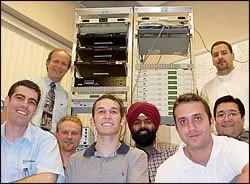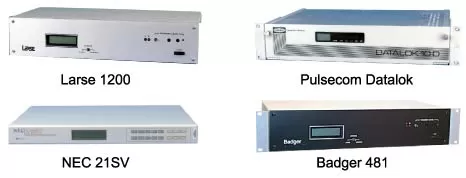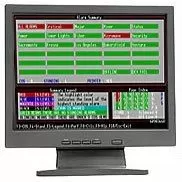Check out our White Paper Series!
A complete library of helpful advice and survival guides for every aspect of system monitoring and control.
1-800-693-0351
Have a specific question? Ask our team of expert engineers and get a specific answer!
Sign up for the next DPS Factory Training!

Whether you're new to our equipment or you've used it for years, DPS factory training is the best way to get more from your monitoring.
Reserve Your Seat Today"DPS told us we didn't have to pay if it didn't work. It works and it's sweet." - Glenn Lippincott, Southern Company

When Glenn Lippincott of Southern Company called DPS Telecom tech support, he wasn't planning on replacing his legacy Badger remotes with a new, custom-engineered network monitoring solution. He thought he had a simple question about his T/MonXM system. But as tech support chief Ron Stover walked him through his T/MonXM configuration, Lippincott saw a menu item that caught his eye. So he asked about it, and the answer helped him improve his network monitoring and save his company hundreds of thousands of dollars.
"Glenn called because his T/MonXM system seemed to be missing a software module," recalled Ron. "I wanted to double-check if it had been installed, so I told Glenn to look through the Installable Options list. While we were going over what was on his system he noticed there was a software module called 'Badger Interrogator.' And Glenn immediately asked, 'Hey, what's that?'"
Lippincott had good reason to be curious, because legacy Badger equipment had become a serious problem for him.

Lippincott works in the Birmingham NOC, where he oversees network monitoring throughout the Southern Company's operational area. Southern Company, a Fortune 500 energy producer and distributor, has a territory that extends through most of Alabama and Georgia and parts of Florida and Mississippi.
Lippincott's monitoring network includes over a hundred legacy Badger 1200 RTUs, polled by two Badger masters.
"It's an older system. The Badger Corporation went out of business and we didn't have support for it. There hasn't been an update in the software in 7 to 8 years. If the masters went bad, I'd be in trouble," said Lippincott.
And unfortunately, that is exactly what was happening. Lippincott's Badger masters were increasingly prone to failure. There was no way of getting support or spare parts for the Badger systems, and Lippincott had to make repairs himself from cannibalized system and a dwindling stock of hoarded spare parts.
"I had kept enough spares over time, so I was managing to keep them up. But once something goes wrong with these systems, it's hard to get them back up again. And it's a pain to set them up again once you have them running, too," said Lippincott.
The Badger remotes were deployed throughout Alabama and Georgia, monitoring older systems, mostly legacy analog microwave sites, according to Lippincott. "The microwave sites are older, but it's all significant equipment," said Lippincott. "Also, in all of the places we use tower lights, which are also monitored by the Badgers, and if they go out it's a pretty hefty fine."

Lippincott knew he had a problem, but he didn't know the solution to his problem was at his fingertips. Lippincott already was using T/MonXM to poll the more than 500 DPS Telecom remotes that were monitoring the newer parts of his network, and he was familiar with its capabilities. But until he saw "Badger" listed as an option in the T/MonXM software, Lippincott didn't know that DPS Telecom had developed a solution for polling legacy Badger remotes.
Lippincott's tech support call to Ron Stover turned into an expert consultation about how to create a legacy support solution for Southern Company.
"Glenn was very interested when I told him there was a software module for legacy Badger support," said Ron Stover. "I told him that we'd developed this solution for another client who had the same problem. We started discussing Glenn's issues with the Badger masters and how we could replace them with his T/MonXM system."
As a test, Ron sent Lippincott a copy of the software module and instructed him to install it on his existing T/MonXM system. But at first it didn't work. The original Badger Interrogator software module for T/MonXM was designed for the Badger model 481 RTU. Lippincott's remotes were Badger 1200, a model that was originally manufactured by Larse as the Larse LarScan Series 1200. The Larse/Badger 1200 a 20-bit protocol, and the DPS Telecom solution was designed for Badger 481 remotes that used 8-bit protocol.
The answer to that issue was a customized solution. "Ron and I talked it over, and DPS gave us a quote to do, and then they did it," said Lippincott.
The customized solution had a hardware component and a software component. The alarm data from Lippincott's Badger remotes is transported in 20-bit packets across an FSK network. DPS Telecom engineers adapted an existing product, the FSK Converter, to convert the data from 20 bits to 8 bits. New software was written to allow T/MonXM to read the Badger protocol.
Lippincott assisted DPS Telecom in development by providing sample equipment to work with. "I provided them with a remote, a Badger master that had gone flaky, and information about the system. Then they built it to my specification," said Lippincott.
Development of the solution took three months, which was just in time, said Lippincott. "It was coming down the wire. I was down to my last two Badger masters that actually worked."
For Lippincott, developing the custom solution was an easy choice. First, it was a no-risk proposition, since Southern Company was not charged for any development work. Second, the system works well.
"DPS told us we didn't have to pay if it didn't work. Shortly I'll be telling them to send me the bill. I just completely moved over my last leg. It works and it's sweet," Lippincott said.
Providing reliable support for the legacy Badger remotes has brought an immediate benefit to Southern Company's business operations. Without the DPS Telecom solution, Southern Company would have had to eventually replace the Badger masters and remotes all at once - a cost that would have amounted to several hundred thousand dollars - at once.
"We're going to swap out the Badger remotes, but now, instead of doing a wholesale change, we can do it as our budget allows," said Lippincott.
The new solution has also improved Southern Company's monitoring. "It's definitely simplified our operations," said Lippincott. "We're all working from the same platform. We don't have to train people on two different systems."
And knowing that his system is supported is a relief. "We don't have to worry about service," said Lippincott. "DPS gives the best service in the world, according to me."
The custom solution created for Glenn Lippincott of Southern Company is now available to all T/MonXM users. The Larse Interrogator software module enables T/MonXM to poll Larse and Badger remote telemetry units, model numbers 1240, 1241, 1242, 1440, 1441, and 1442.
Several of our clients are now using this software, and if you have legacy Larse or Badger remotes in your network, you should too. Polling your legacy remotes via T/MonXM will give you a smooth migration path to upgrading your network, prevent the need for forklift swap-outs of legacy remotes, and let you use T/MonXM's advanced features with alarms from your legacy remotes.
For more information about how the Larse Interrogator software module can solve your legacy support issues, contact a DPS Telecom Applications Engineer today at 1-800-693-0351.